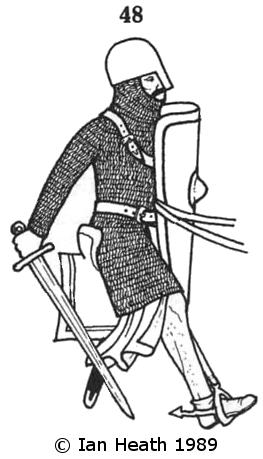
Find the perfect fit with Amazon Prime. Try Before You Buy.
WELSH UCHELWYR, c.1200
An extract from Armies of Feudal Europe 1066-1300by Ian Heath



48. WELSH UCHELWYR, c.1200
A description of Welshmen in Edward I's army in Flanders in 1297 speaks of them being unarmoured, wearing red linen tunics, and some armed with javelins. Though William le Breton and Giraldus himself also state that Welsh soldiers were unarmoured the latter nevertheless reports that some, clearly the upper-classes, wore light armour, which he describes as comprising helmet, short mail corselet, circular shield (also carried by infantry spearmen and described in various sources as being coloured white, gold, silver or blue) and - very occasionally - mail hosen. Such warriors were the uchelwyr or noblemen who constituted the teulus of the Welsh princes and fought on horseback as marchogs (knights), mounted 'on swift, mettlesome horses which are bred locally', but who were prepared to dismount and fight on foot whenever necessary; Richard I had such cavalry as well as archers with him in France at the end of the 12th century, paying them 4d. a day if they had one horse and 6d. if they had two. The figure depicted is based on the seal (c.1214) of Llywelyn ap Iorwerth, Prince of Gwynedd 1194-1240; he differs from Giraldus description only in the substitution of a conventional long shield in place of the round one, probably a late-12th or early-13th century development. Principal armament was probably a lance as elsewhere, though it is certainly possible, even likely, that javelins were also carried in the earlier part of this period.
It seems likely that in the course of the 13th century the uchelwyr would have been influenced by the styles of arms and armour in use amongst the contingents of the marcher lords, and that an even more 'Anglicised' harness would have resulted; in 1316, for instance, the confiscated armour of the rebel Llywelyn Bren (of the royal house of Sengbenydd in Glamorgan) is recorded to have comprised an aketon; a gambeson, 3 haubergeons, an iron breastplate, a buckram armour (doubtless a coat-of-places), an iron helmet, 2 pairs of maunc' (vambraces), a shield, and a pair of plate gauntlets. Though this harness is somewhat more comprehensive than that generally in use at the end of the 13th century, the significant point is that it would have made Llywelyn Bren indistinguishable from his English adversaries. In addition heraldry was in use amongst the Welsh nobility by the late-12th century, as is confirmed by surviving seals.